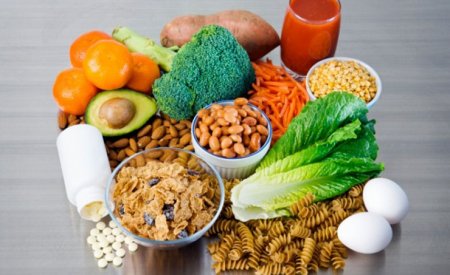Folic acid in foods - for what it is
What is folic acid the body
Few know that folic acid is involved in the formation of deoxyribonucleic acid, or DNA, which provides storage and transmission from generation to generation, the genetic information.
The first folic acid is used to treat and prevent blood deficiency of this vitamin.
Folic acid is prescribed to pregnant women, as it carries the risk of a lack of abortion and the development of severe disease in children.
A sufficient amount of folic acid every day extends clarity of mind in old age keeps longer good vision and hearing.
Vitamin B9 is necessary for the body to form new cells, including skin, hair and nails.
Folic acid, together with other B vitamins are needed to maintain a healthy heart and blood vessels, nervous system.
Vitamin B9 is essential for the synthesis of amino acids, serotonin, norepinephrine.
It reduces the amount of the amino acid homocysteine, which promotes the formation of atherosclerotic plaques in blood vessels, as well as a negative impact on the course of kidney disease.
Folic acid reduces the manifestation of symptoms of the disease called vitiligo.
It is proved that folic acid in increased amounts during pregnancy reduces the risk of congenital diseases in babies.
Dosage rate of folic acid daily for adults is 400 micrograms allowed but intake as food additive up to 1 mg per day.
Folic acid deficiency
Prolonged deficiency of this vitamin, there is anemia, impaired intestinal capacity to absorb nutrients from food.
Lack of folic acid can lead to mental disorders, depression, hair loss and poor growth of nails.
Symptoms lack of vitamin B9:
Weakness;
Headache;
Fast fatiguability;
Pallor;
Memory impairment.
Why is there a deficiency of folic acid in the body
Lack of vitamin B9 can occur in people who prefer to eat mostly processed foods and their diet does not contain enough fresh vegetables. The fact is that during heat treatment, 50-90% of folic acid is lost. For example, in fresh milk contains much folic acid, but pasteurisation and boiling, mostly destroyed.
Long-term treatment with antibiotics, the intestinal microflora is destroyed, but as probiotics not only produce B vitamins, but also help them to better assimilated, it is often the lack of a particular vitamin is associated with this circumstance.
How to take folic acid
The daily dose for an adult - 400 mcg, but the day is allowed a maximum of 1 mg for the prevention when planning pregnancy and during the first month. In addition, under certain health conditions, physicians can prescribe a few grams per day of folic acid, such as vitiligo taking 5 mg.
Products containing folic acid
Folic acid found in most fruits and vegetables, especially rich in this vitamin leafy salads and green vegetables. Naturally, to get enough of this substance, you need to eat as much fresh, unprocessed foods as possible.
Spinach. Not the most popular in our leafy vegetables, but it is very rich in vitamins and minerals. In 100 grams of fresh spinach it contains almost 50% of daily folic acid standards. Besides - 59% of vitamin A, vitamin C 34%, 450% of vitamin K, 22% iron, 22% magnesium and 43% of manganese required.
Beans - 100 grams of cooked beans provides 50% daily low folic acid.
Oranges - Orange is one of folic acid 40mkg or 10% of the daily norm.
Lentils - 100 grams of cooked lentils provides 49% of the necessary folic acid on day 1.
Broccoli - 63 g / 100 g or 16% of the daily allowance;
Cauliflower - 55 mg / g or 14% of the daily allowance;
Brussels sprouts. Except that 100 grams of cooked cabbage contains 25% of folic acid. This vegetable contains high amounts of vitamin A, K, manganese and potassium.
Beet. It is extremely surprising for its nutritional properties, the product. From fresh beet juice and drink do to restore the liver and cleanse the body of toxins. As for vitamin B9, in 100 grams of cooked beets has about 34% of the daily dose of the desired compound.
pumpkin seeds. 100 grams of the product contains 14% Daily Value of vitamin B9;
Nuts. Since the levels of folic acid in cooked food is sharply reduced, it is recommended not to choose fried nuts.
The main thing, remember that the best body to absorb vitamins, including folic acid from food, so always give preference to a varied diet rather than food additives. If, however, no pharmacy multivitamin can not do, I always take them with food.
Few know that folic acid is involved in the formation of deoxyribonucleic acid, or DNA, which provides storage and transmission from generation to generation, the genetic information.
The first folic acid is used to treat and prevent blood deficiency of this vitamin.
Folic acid is prescribed to pregnant women, as it carries the risk of a lack of abortion and the development of severe disease in children.
A sufficient amount of folic acid every day extends clarity of mind in old age keeps longer good vision and hearing.
Vitamin B9 is necessary for the body to form new cells, including skin, hair and nails.
Folic acid, together with other B vitamins are needed to maintain a healthy heart and blood vessels, nervous system.
Vitamin B9 is essential for the synthesis of amino acids, serotonin, norepinephrine.
It reduces the amount of the amino acid homocysteine, which promotes the formation of atherosclerotic plaques in blood vessels, as well as a negative impact on the course of kidney disease.
Folic acid reduces the manifestation of symptoms of the disease called vitiligo.
It is proved that folic acid in increased amounts during pregnancy reduces the risk of congenital diseases in babies.
Dosage rate of folic acid daily for adults is 400 micrograms allowed but intake as food additive up to 1 mg per day.
Folic acid deficiency
Prolonged deficiency of this vitamin, there is anemia, impaired intestinal capacity to absorb nutrients from food.
Lack of folic acid can lead to mental disorders, depression, hair loss and poor growth of nails.
Symptoms lack of vitamin B9:
Weakness;
Headache;
Fast fatiguability;
Pallor;
Memory impairment.
Why is there a deficiency of folic acid in the body
Lack of vitamin B9 can occur in people who prefer to eat mostly processed foods and their diet does not contain enough fresh vegetables. The fact is that during heat treatment, 50-90% of folic acid is lost. For example, in fresh milk contains much folic acid, but pasteurisation and boiling, mostly destroyed.
Long-term treatment with antibiotics, the intestinal microflora is destroyed, but as probiotics not only produce B vitamins, but also help them to better assimilated, it is often the lack of a particular vitamin is associated with this circumstance.
How to take folic acid
The daily dose for an adult - 400 mcg, but the day is allowed a maximum of 1 mg for the prevention when planning pregnancy and during the first month. In addition, under certain health conditions, physicians can prescribe a few grams per day of folic acid, such as vitiligo taking 5 mg.
Products containing folic acid
Folic acid found in most fruits and vegetables, especially rich in this vitamin leafy salads and green vegetables. Naturally, to get enough of this substance, you need to eat as much fresh, unprocessed foods as possible.
Spinach. Not the most popular in our leafy vegetables, but it is very rich in vitamins and minerals. In 100 grams of fresh spinach it contains almost 50% of daily folic acid standards. Besides - 59% of vitamin A, vitamin C 34%, 450% of vitamin K, 22% iron, 22% magnesium and 43% of manganese required.
Beans - 100 grams of cooked beans provides 50% daily low folic acid.
Oranges - Orange is one of folic acid 40mkg or 10% of the daily norm.
Lentils - 100 grams of cooked lentils provides 49% of the necessary folic acid on day 1.
Broccoli - 63 g / 100 g or 16% of the daily allowance;
Cauliflower - 55 mg / g or 14% of the daily allowance;
Brussels sprouts. Except that 100 grams of cooked cabbage contains 25% of folic acid. This vegetable contains high amounts of vitamin A, K, manganese and potassium.
Beet. It is extremely surprising for its nutritional properties, the product. From fresh beet juice and drink do to restore the liver and cleanse the body of toxins. As for vitamin B9, in 100 grams of cooked beets has about 34% of the daily dose of the desired compound.
pumpkin seeds. 100 grams of the product contains 14% Daily Value of vitamin B9;
Nuts. Since the levels of folic acid in cooked food is sharply reduced, it is recommended not to choose fried nuts.
The main thing, remember that the best body to absorb vitamins, including folic acid from food, so always give preference to a varied diet rather than food additives. If, however, no pharmacy multivitamin can not do, I always take them with food.

